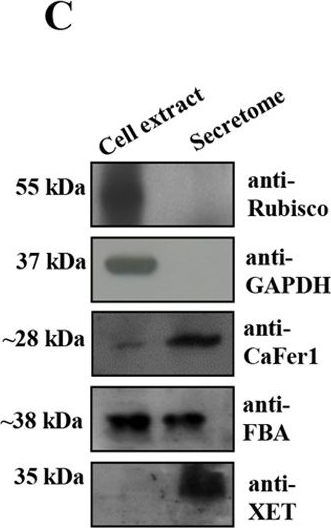1

Anti-ALD | Fructose-1,6 bisphosphate aldolase
AS08 294 | Clonality: Polyclonal | Host: Rabbit | Reactivity: A. thaliana, B. napus, C. arietinum, E. tef, G. gracilis, O. sativa, P. falciparum, T. salsuginea
- Product Info
-
Immunogen: overexpressed cytosolic fructose 1,6 bisphosphate aldolase (ALD) based on the sequence from Arabidopsis thaliana Q9LF98, At3g52930
Host: Rabbit Clonality: Polyclonal Purity: Serum Format: Lyophilized Quantity: 100 µl Reconstitution: For reconstitution add 100 µl of sterile water Storage: Store lyophilized/reconstituted at -20°C; once reconstituted make aliquots to avoid repeated freeze-thaw cycles. Please remember to spin the tubes briefly prior to opening them to avoid any losses that might occur from material adhering to the cap or sides of the tube. Tested applications: Western blot (WB) Recommended dilution: 1 : 5000 (WB) Expected | apparent MW: 38 | 38 kDa
- Reactivity
-
Confirmed reactivity: Arabidopsis thaliana, Brassica napus, Cicer arietinum, Eragrostis tef, Gracilaria gracilis (red algae), Oryza sativa, Plasmodium chabaudi, Plasmodium falciparum, Thellungiella salsuginea Predicted reactivity: Glycne max, Nicotiana attenuata, Nicotiana tabacum, Oryza sativa, Picea sitchensis, Physcomitrium patens, Pisum sativum, Populus jackii, Spinacia oleracea, Vitis vinifera, Zea mays
Species of your interest not listed? Contact usNot reactive in: Synechocystis sp.
- Application Examples
-
Application examples: 
Reactant: Oryza sativa (Asian rice)
Application: Western Blotting
Pudmed ID: 26552588
Journal: Sci Rep
Figure Number: 6A
Published Date: 2015-11-10
First Author: Dixit, G., Singh, A. P., et al.
Impact Factor: 4.13
Open PublicationWestern blot analysis of selected candidate proteins (AtpB, 2Fe-2S, GLN2, Psb R, PRK, ALD) with their corresponding molecular weight in rice leaves during As stress under various S regimes (A); RuBisCo large subunit a band in coomassie blue staining (CBB) SDS gel served as a loading control (B), which used for normalization of detected proteins in densitometry studies (C) fold change indicated with respect of control samples.

Reactant: Cicer arietinum (Chickpea)
Application: Western Blotting
Pudmed ID: 27503257
Journal: Sci Rep
Figure Number: 7C
Published Date: 2016-08-09
First Author: Parveen, S., Gupta, D. B., et al.
Impact Factor: 4.13
Open PublicationCompartmentalization of CaFer1.(A) Bioinformatics prediction of CaFer1 to the chloroplast and the secretome. (B) The model of CaFer1 generated by comparative modeling, shown in ribbon view (right upper panel). The percent identity of modeled structure of CaFer1 with the template, and the RMSD values were given in the table (right lower panel). The non-conserved amino acid sequence of CaFer1 (red color) from that of other phytoferritins with predicted signal peptide, is shown in left panel. (C) Purity assessment and immunodetection of CaFer1, FBA and XET in the chickpea secretome. Immunoreactions with Rubisco and GAPDH served as negative controls for secretome. (D) BFA-mediated inhibition of CaFer1 and thioredoxin transport. ‘?BFA’ represents the untreated secretome. (E) CaFer1 was detected in extracellular space and chloroplast of OE plants with anti-FLAG antibody. XET was used as positive control for extracellular space and rubisco for chloroplast. WT, wild-type; OE, CaFer1-overexpressing.
- Additional Information
-
Additional information (application): This product can be sold containing ProClin if requested - Background
-
Background: Fructose-1,6 bisphosphate aldolase (ALD) is an enzyme catalazying a key reaction of glycolysis and energy production, converting D-fructose- 1,6-bisphospate into dihydroxyacetone phosphate and D-glyceraldehyde-3-phosphate. This enzyme is present in plant and animal tissues. Plant enzyme is a class I aldolase which does not require a bivalent metal cofactor. It is located to outer mitochondrial membrane.
- Product Citations
-
Selected references: Wang et al. (2018). iTRAQ-based quantitative proteomics analysis of an immature high-oleic acid near-isogenic line of rapeseed. Molecular Breeding January 2018, 38:2.
Kamies et al. (2017). A Proteomic Approach to Investigate the Drought Response in the Orphan Crop Eragrostis tef. Proteomes. 2017 Nov 15;5(4). pii: E32. doi: 10.3390/proteomes5040032.
Foley et al. (2017). A Global View of RNA-Protein Interactions Identifies Post-transcriptional Regulators of Root Hair Cell Fate.Dev Cell. 2017 Apr 24;41(2):204-220.e5. doi: 10.1016/j.devcel.2017.03.018.
Parveen et al. (2016). Chickpea Ferritin CaFer1 Participates in Oxidative Stress Response, and Promotes Growth and Development. Sci Rep. 2016 Aug 9;6:31218. doi: 10.1038/srep31218.
Yam et al. (2016). Characterization of the Plasmodium Interspersed Repeats (PIR) proteins of Plasmodium chabaudi indicates functional diversity. Sci Rep. 2016 Mar 21;6:23449. doi: 10.1038/srep23449.
Dixit (2015). Sulfur alleviates arsenic toxicity by reducing its accumulation and modulating proteome, amino acids and thiol metabolism in rice leaves. Sci Rep. 2015 Nov 10;5:16205. doi: 10.1038/srep16205.
Vera-Estrella et al. (2014). Comparative 2D-DIGE analysis of salinity responsive microsomal proteins from leaves of salt-sensitive Arabidopsis thaliana and salt-tolerant Thellungiella salsuginea. J Proteomics. 2014 Jun 2. pii: S1874-3919(14)00288-7. doi: 10.1016/j.jprot.2014.05.018. - Protocols
-
Agrisera Western Blot protocol and video tutorials
Protocols to work with plant and algal protein extracts
Oxygenic photosynthesis poster by prof. Govindjee and Dr. Shevela
Z-scheme of photosynthetic electron transport by prof. Govindjee and Dr. Björn and Dr. Shevela - Reviews:
-
Rene | 2010-08-02This antibody was used on Gracilaria gracilis with great sucess. A 1:5000 primary antibody dilution was used and a 1:10 000 secondary antibody dilution was used.



